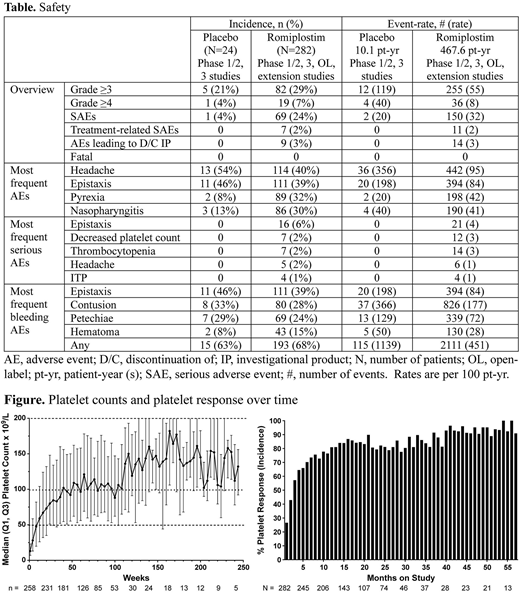Abstract

Background: Romiplostim is approved globally for use in adults with ITP and in the EU for children with ITP. More comprehensive data are needed on the use of romiplostim in children with ITP.
Objective: To examine the safety and efficacy of romiplostim in trials in children with ITP.
Methods: Data were combined from 5 romiplostim trials in children with ITP, both placebo-controlled (a phase 1/2 and a phase 3 trial) and open-label (a 3-year trial and 2 extension trials); trial data have been reported previously (Bussel Blood 2011, Bussel PBC 2014, Tarantino Lancet 2016, Tarantino ASH 2017, Grainger ASH 2017). Platelet counts in the 4 weeks after use of rescue medication were excluded from analyses. Descriptive statistics were used. Number (n), mean, standard deviation (SD), median, quartile range (Q1, Q3), minimum (min), and maximum (max) for continuous variables, and number and percentage for categorical variables were provided.
Results: Patients (N=286, 24 initially placebo and 262 initially romiplostim) had median (Q1, Q3) age of 10 (6, 13) years, ITP duration of 1.9 (1, 4) years, and baseline platelet count of 14 (8, 23)×109/L. Previously, 88% had received corticosteroids, 87% IVIg, and 21% rituximab; 23% had received >3 prior treatments and 7% had prior splenectomy. Of the 282 patients exposed to romiplostim (20 initially received placebo), the median (min, max) duration of treatment was 65 (8, 471) weeks, with a median (min, max) average weekly dose of 6.6 (0.1, 9.7) μg/kg; total exposure was 468 patient-years. The most common reasons for discontinuing the parent study for romiplostim-treated patients were per protocol (19%; eg, sponsor decision, death, lost to follow-up), consent withdrawn (3%), noncompliance (1%), and administrative decision (1%).
Of romiplostim-treated patients, 24% had serious adverse events (SAEs), most commonly epistaxis, low platelet counts, and headache (Table). There were 7 cases of postbaseline neutralizing antibody against romiplostim: 2 transient and 5 persistent. There were no neutralizing antibodies against endogenous TPO. For patients undergoing bone marrow biopsies in the 3-year open-label trial, there were no findings of collagen or bone marrow abnormalities (Year 1 n=27, Year 2 n=5, vs. baseline) (Grainger et al, ASH 2017). One patient had an increase in modified Bauermeister bone marrow grade from 0 to 2 (fine reticulin fiber network) with no associated AEs (the only AEs were a cold and injection site pain); per protocol, there was no follow-up biopsy. Once at a steady dose of 10 μg/kg, most (11/16) of this patient's platelet counts were ≥30×109/L. Investigators reported thrombocytosis AEs; 1 patient had a platelet count of 1462×109/L at Week 14 for 1 week and another had elevated platelet counts 10 times between Weeks 20-172 (max of 872×109/L); there were no associated thrombotic events.
Median platelet counts rose quickly and were over 50×109/L from Week 12 on (Figure). Platelet response rates also rose quickly. Overall, 89% of romiplostim-treated patients (vs 8% of placebo) had a platelet response (platelet counts ≥50×109/L; Figure). For romiplostim-treated patients, the first platelet responses occurred after a median of 6 weeks. The median % (Q1, Q3) of months responding was 76% (25%, 93%) and # of months responding was 11 (3, 20); from time of first monthly response, the median (Q1, Q3) % of months responding was 92% (75%, 100%) and # of months responding was 14 (7, 23). Nineteen romiplostim-treated patients discontinued all ITP therapies including romiplostim for ≥6 months while maintaining platelet counts ≥50×109/L (here defined as remission). These treatment-free periods lasted a median (Q1, Q3) of 12 (8, 14) months; no placebo patients remained free of treatment. There were no clear differences between those who did and did not enter remission (ie, age, sex, race, past treatment, ITP duration, baseline platelet count). Bleeding was reported for most (68%) patients: mostly grade 1/2, with 10% having grade 3 bleeding (most commonly epistaxis in 13 patients) and 2 patients having grade 4 bleeding (both reported as "ITP").
Conclusions: In this comprehensive database of romiplostim ITP trials in 286 children with 468 patient-years of romiplostim exposure, romiplostim was well tolerated. With romiplostim, the vast majority (89%) of patients had a platelet response, with some children able to discontinue all ITP treatments for ≥6 months.
Tarantino:Health Resources and Services Administration: Research Funding; Centers for Disease Control and Prevention: Research Funding; Amgen: Membership on an entity's Board of Directors or advisory committees; Genentech: Membership on an entity's Board of Directors or advisory committees; Shire: Membership on an entity's Board of Directors or advisory committees, Speakers Bureau; Pfizer: Other: Reviews grants; Novo Nordisk: Membership on an entity's Board of Directors or advisory committees, Research Funding, Speakers Bureau; Grifols: Research Funding, Speakers Bureau. Despotovic:AmGen: Research Funding; Sanofi: Consultancy; Novartis: Research Funding. Grainger:Biotest: Consultancy; Ono Pharmaceuticals: Consultancy; Amgen: Consultancy, Honoraria, Other: Educational grant; Novartis: Honoraria, Membership on an entity's Board of Directors or advisory committees. Cooper:Amgen, Novartis: Consultancy, Honoraria, Membership on an entity's Board of Directors or advisory committees. Kim:Amgen Inc.: Employment, Equity Ownership. Eisen:Amgen Inc.: Employment, Equity Ownership.
Author notes
Asterisk with author names denotes non-ASH members.

This icon denotes a clinically relevant abstract


This feature is available to Subscribers Only
Sign In or Create an Account Close Modal